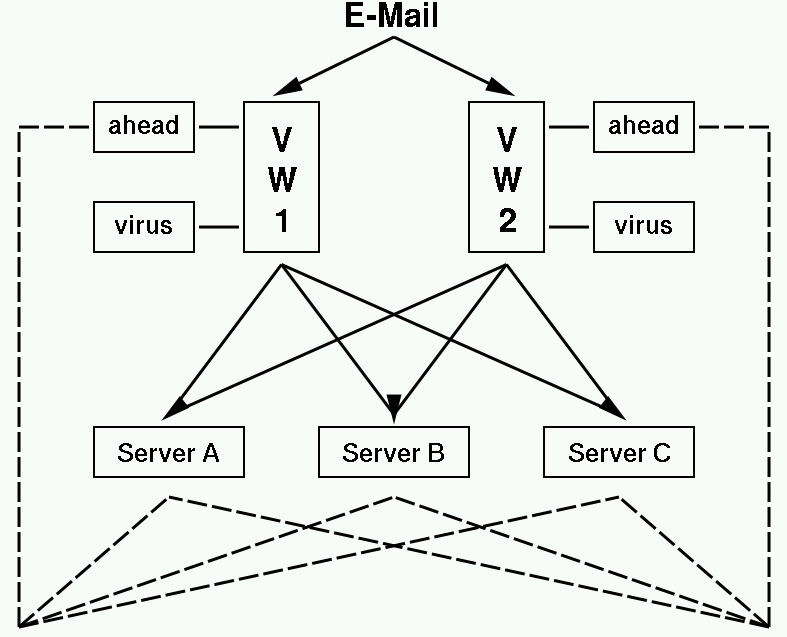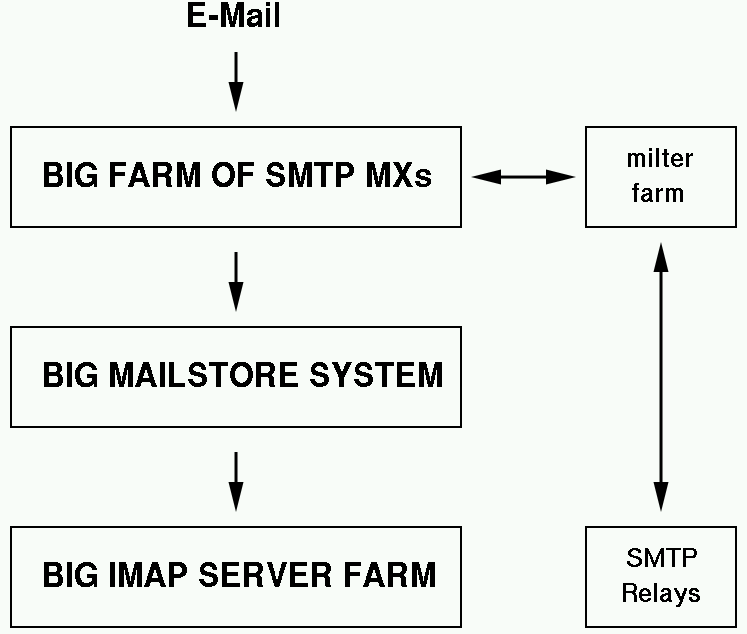Scalable SMTP E-Mail Filtering
Methods and Techniques
UCCSC 2007, Santa Cruz
Jon Kuroda
UC Berkeley EECS, CUSG
jkuroda[at]EECS[dot]Berkeley[dot]EDU
http://www.EECS.Berkeley.EDU/~jkuroda/talks/mailfiltering/
Note: press space to go forward. pageup/down keys work too
This is an (x)html document in the S5 presentation system, so there are lots of links one can follow.
Some Alternate Titles
"Content Filtering on the Cheap"
"Content Filtering that Works (Better)"
"Virus Scanning and Spam Tagging That Sucks Less"
"Virus Scanning for a Non-Ideal World"
"Mail Filtering for the Masses"
"Anti-Virus Is Hard. Lets Go Shopping!"
Topics (and Non-Topics)
- What I will be (or have been) talking about
- Background/Historical Information
- Personal Caveats
- How different filtering systems work
- Ways to deploy email filtering - including examples
- Crazy Ideas and Odds and Ends
- What I will not be talking about as much
- My (MTA|OS) is better than your (MTA|OS)
- Every single implementation detail
- Measures outside of a filtering context
- What I hope you (and I) will get out of this
- Some understanding of how e-mail filters work and how to use them
- Some tools and ideas to take home and try
- If I am lucky, a good laugh
What's this all about?
- Scalable
- Cheap and Easy to get more capacity (Pay what you want as you go)
- Does More. Costs Less. Doesn't Suck (as much)
- Flexible
- Useful in situations other than my own
- Looking for a modular/toolkit approach
- Server Based
- Primarily interested in the MTA/SMTP side
- Less so in delivery-time systems such as Sieve, .forward/procmail, or MUA filters
- Content-Filtering
- Anti-Virus/Spam
- Data Scrubbing/Retention
- Auto-Spell-Checking / Auto-Translation
A (Very) Brief History of E-mail Servers
- In the beginning ...
- One big server - Shell/Mail/FTP/everything
- Servers became (more) affordable - Proliferation and decentralization
- Whoa Nellie - Consolidation

- Results
- Viruses, Spam, Server Attacks, SMTP relay abuse, ...
- Partially consolidated services
- Legacy servers
- Market for anti-(bad stuff) software and systems
- Market for people who can manage all of this
Mmmm, Job Security ...
Once upon a time ...
It's 2003 in 399 Cory Hall ...
- 20+ supported separate, disjoint systems accepting email
- Numerous legacy research group mailservers - maillists and mailspools
- Research systems that accept input via SMTP
- One Exchange server.
- Policy (then a draft policy) requiring anti-virus measures on mailservers
- 2. Anti-virus software:
- Anti-virus software for any particular type of device currently listed on the Approved Software website must be running and up-to-date on every level of device, including clients, file servers, mail servers, and other types of campus networked devices.
- Departmental (@EECS / @CS) MX hosts already had it
- I was the new guy
- "Hey Jon ..." Beware these words.
Caveats
- I'm a *nix/sendmail guy who installed anti-virus software
- Examples involving these will have the most detail
- I don't do MS Exchange, but I will talk about it (a little)
- I'm a realist, not an idealist
- I don't work in an ideal IT world
- I try not to assume one.
- There is nothing new here
- I didn't actually think this was that novel
- No (in my opinion) out of the ordinary ideas
- But, as always, the work is in the documentation

Filters: An (Over) Simplified Look
Pseudocode describing what a filter does. Note there there are I/O and side-effects.
while (<INPUT>)
if (/PATTERN/) {
mangle $input;
print OUTPUT;
do some_side_effect;
} else {
print OUTPUT;
do some_other_side_effect;
}

Filters: The Engine
- The "brains", does the work of making filtering and other decisions
- Anti-virus/spam
- "Scrubbing" messages for sensitive data
- Anything from rejecting a message to passing it on unmodified
- Side-Effects
- Logging/Notifications
- Updating cached information
- Sometimes, all we care about are the side-effects
- It may also depend on databases that require periodic* updating
- Virus/Spam databases
- SpamAssassin Bayesian Analysis (sa-learn)
- Spam Host lists
The Ins and Outs of Filter I/O
Great, we have a filter engine, but how do we get email in and out of the filter?- First, a detour to talk about Pre/Post-queue filtering
- Do we have to let people in the door just so we can kick them out?
- MTA Plugins
- Embrace the MTA extensions
- SMTP-aware Filter
- It's an MTA, it's a Filter, no wait ... it's both!! Well, sorta
- API/Protocol
- Good fences make for good filtering.
- Network Proxy (Extra Slide)
- Black Magic that noone has done, probably
Filter I/O: Pre/Post-queue Filtering, a Slide Without a Home
Filter before or after queueing email? Pre-queue filtering lets one reject mail during an SMTP connection, but it can cause timeouts. Postfix has some good notes on the pros and cons of pre-queue filtering.Pre-queue filtering:
220-mail.example.com ESMTP JavaMail 6.2 Mon, 31 Jul 2006 20:01:23 -0700 ehlo poland.example.com 250-mail.example.com Hello poland.example.com [192.0.34.166] Mail From: <exile@poland.example.com> 250 OK Rcpt To: <president@example.com> 250 Accepted data 354 Enter message, ending with "." on a line by itself X5O!P%@AP[4\PZX54(P^)7CC)7}$EICAR-STANDARD-ANTIVIRUS-TEST-FILE!$H+H* . 550 DENIED!! Message contains malware (ClamAV:Eicar-Test-Signature)
Versus post-queue, where filtering occurs but not till after email is accepted
220-post.example.com ESMTP JavaMail 6.2 Mon, 31 Jul 2006 20:02:23 -0700 ehlo siberia.example.com 250-post.example.com Hello siberia.example.com [192.0.34.166] Mail From: <exile@siberia.example.com> 250 OK Rcpt To: <president@example.com> 250 Accepted data 354 Enter message, ending with "." on a line by itself X5O!P%@AP[4\PZX54(P^)7CC)7}$EICAR-STANDARD-ANTIVIRUS-TEST-FILE!$H+H* . 250 2.0.0 k713JO1n055810 Message accepted for delivery
Filter I/O: Pre-queue Filters: SMTP Timeouts and Consequences
Are SMTP timeouts a real cause for concern with pre-queue filtering?
-
RFCs 2821 and 1123 say one should wait 10 minutes after sending the terminating "."
Not "shall" or "must" but merely should. - Sendmail defaults to 1hr, Postfix to 10min, No clue about QMail or Exchange
- It's an uncertain world out there. Best to be on your toes.
What does this mean?
It means don't run a filter pre-queue just because it's possible. Consider its impact on overall performance and its ability to stay within those suggested timeouts on SMTP connections.
But do I need to worry?
- In all practicality, not before the fact.
- Check filters before putting into production.
- Keep tabs on performance to see if a filter is causing timeouts.
Filter I/O: Pre-queue Filters: What to run pre-queue?
- Must be pre-queue
- Anything that issues SMTP Return Codes
Example: Greylisting "Deferred Delivery" and "Message Accepted" don't mix. - Any filter that is a dependency (See below)
- Anything that issues SMTP Return Codes
- Very good ideas
- Anything quick (a relative term) that can cut down load for bigger filters later on
- DNSBL
- SPF checks
- SMTP Compliance
- Not so Good
- Message Body Inspection/filtering
- Anti-spam/virus
- Unless depended on by a pre-queue filter
Example: Greylist all mail with a high spam-score.
- Anything slow or heavy on CPU/IO/memory use
- Anything that has only side-effects
Filter I/O: MTA Plug-in
Designed for a particular MTA (such as Microsoft Exchange w/VSAPI?)- Becomes part of the MTA (MS Exchange VSAPI uses DLLs)
- Integration can increase performance
- Filter can make use of MTA specific features to provide non-SMTP filtering
Essentially yields 'full-featured' Standalone SMTP-aware Filter
- Can accept and deliver incoming email
- Retains all of the MTA's own features, adding in filtering
Operates in MTA's process space
- Often shares access privileges
- Problem with filter can affect MTA from within
- Even if somehow separate processes, often share system resources
I don't find them that flexible, but these can work well for specific situations.
Filter I/O: SMTP-aware Filter
It speaks SMTP, but do we call it an 'MTA'?- May not have all the features found in your actual MTA:
- DNSBL, RCPT Verfication, LDAP, Full SMTP routing, running hot water ... - Can relay to a "Real MTA" or be part of a "Dual MTA" setup, described later
SMTP usually means post-queue filtering only
- Postfix has a workaround which is useful for Dual-MTA setups.
Use Postfix as a pre-queue-capable frontend to a post-queue-only filter.
| Hardware Boxes | Software Only |
|---|---|
|
* denotes what we use in our group or our department ** what we have used. |
No room for pretty pictures here :( Next slide
Filter I/O: SMTP-aware Filter Diagram
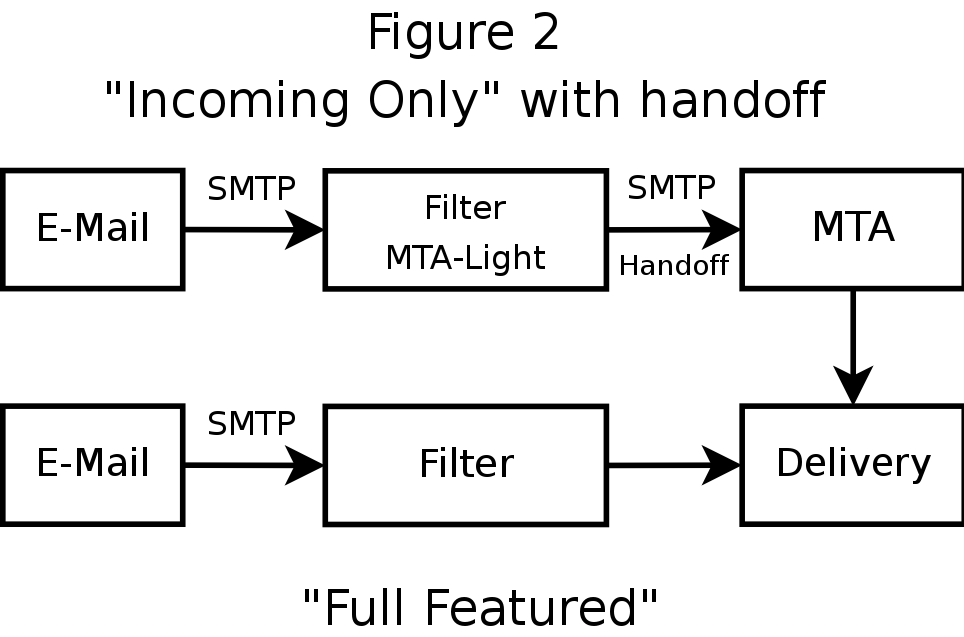
Filter I/O: API/Protocol
MTA and filter are separate and communicate via a defined protocol or API- Filter is a separate process, possibly on another system
- Capable of supporting any MTA modulo API support
- Combined with an MTA, one can build a Full Featured SMTP-aware Filter
Like an MTA Plugin, this augments an MTA instead of replacing it, but, unlike plugins, filters and MTA are explicitly separate. For high performance computing types, think shared memory versus message passing.
Two well known API/Protocols:
- SMTP aka RFC 2821 (or LMTP/QMTP/...)
- Sendmail's Content Management API aka Milter
- Lots of for-pay and open/cheap-source options here
Filter I/O: Filtering Protocol Diagram
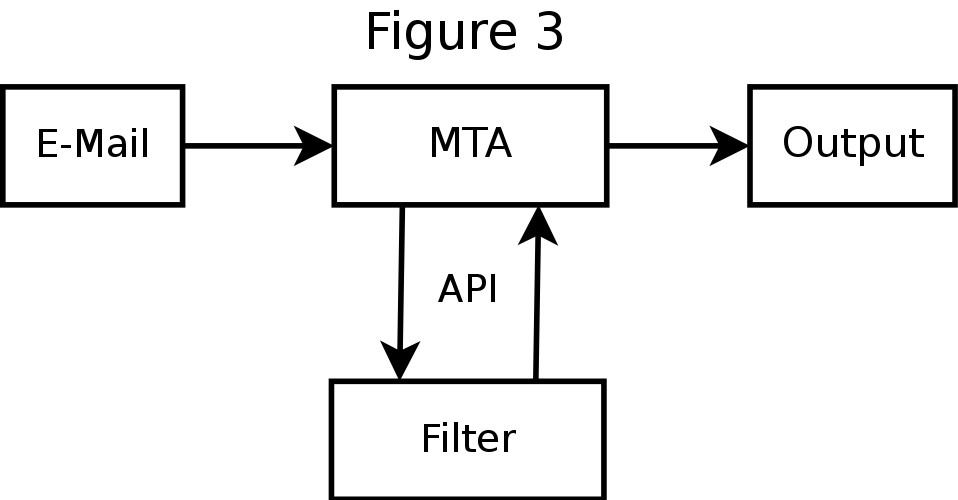
Filter I/O: SMTP and Milter compared
SMTP - Everyone speaks it, some better than others- Example: Any SMTP-aware Filter
- Protocol was not meant for this task — it just happens to work
- Unidirectional, may require "dual MTA" setup
- Often implies post-queue filtering
- Inherently post-queue filtering only
- Postfix has some workarounds.
- Examples:
- Trend Viruswall (Sendmail Edition) or their new Antivirus for Sendmail
- SpamAssassin and ClamAV milters (many of these)
- Sophos Puremessage for Unix
- Kaspersky Anti-Virus for Sendmail with Milter API
- Open API, though only Sendmail & Postfix(≥ v2.3) currently have support
- Protocol designed for filtering
- bidirectional - no need for "dual MTA" setup
- can do pre-queue and post-queue filtering
But Sendmail and Postfix use only for pre-queue
Filter I/O: Dual MTA and Milter Compared
Dual MTA needs at least one extra* MTA listening on different port/socket- MTA-A accepts mail, relays via SMTP/LMTP on arbitrary port/socket to filter
- Filter sends filtered email via SMTP/LMTP to MTA-D on arbitrary port/socket
- MTA-D continues processing e-mail
- For additional filters, chain filters or add more MTA-D's
- limited filter configurations can limit chaining
- adding MTA-D's is messy and can interfere with pre-queue filtering
Milter setup only needs one MTA running
- MTA accepts incoming mail, sends to milter over a socket
- The milter sends filtered email back over the same socket
- MTA continues processing e-mail, perhaps to other milters
- Add milters till you run out of resources, still need only one MTA
Filter I/O: Dual MTA and Milter Compared Diagram
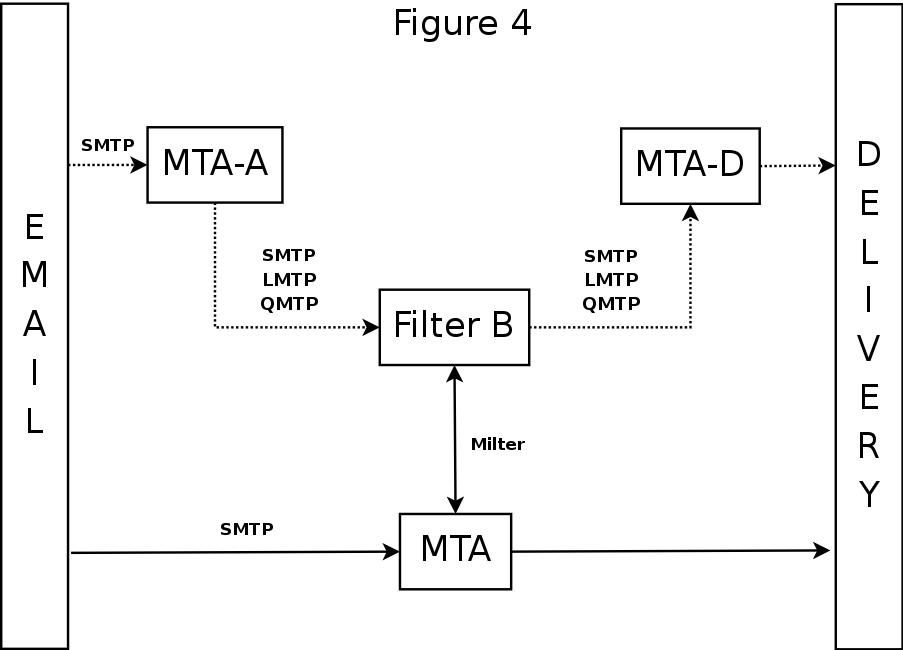
Filter I/O: Dual MTA and Milter Compared - Multi-Filter Diagram

Filter: Side Effects and Other Random Bits
Notification E-mails- "You sent a virus" - useless and annoying. Turn it off
- "You got a virus" - almost as useless and annoying, maybe amusing
- "Virus Deleted" (Cleaned email sent out) - useless/annoying, maybe amusing
- Not a Side-effect but actual bona-fide filter I/O
Saving Viruses/Spam
- Potentially amusing, harmful, and profitable
Logging
- How else will you know if this works
- How else will you fix it when it doesn't?
- How else will you know if you need more capacity?
- How else will you get that raise?
Right. Raise. UC system
"Virus Deleted" Emails In EECS, we actually send the cleaned e-mails. A default sieve rule on our IMAP server auto-files all such cleaned e-mails to a special folder where users can ignore them or be impressed by how much virus-laden email we're catching for them.
Saving Viruses A user in our department who was doing work with windows viruses asked if we had any he could get his hands on. We save viruses mostly for our amusement and to run stats, but we were able to give him a CD of viruses and get paid some T&M for it.
Deployment: What to do with these tools
We now have some pieces that can be combined in many ways, how can we use them?Install it Everywhere
- The Simple (But Stupid?) Life
MX Filter
- The "Big Guy at the Entrance" way.
Network Filter Service (The Other Other NFS)
- It seems slick, but is it really useful?
Deployment: Install It Everywhere
Pretty self-explanatory
Pros- Braindead simple
- Fine if you have only one or two systems to manage
But that is not the focus here.
Cons
- Multiple points of (mis)management
- May conflict with licensing schemes
- Filter may not be supported/available on some platforms
This does not count as scalable, mmm'kay?
Deployment: MX Filter in a Nutshell
Essentially an SMTP relay that filters along the way
Major Steps- build (or buy) one or more SMTP-aware Filters
- Set up SMTP-aware Filters for handoff to 'client MTAs'
- MX all of your 'client MTAs' to the SMTP-aware Filters
- Sit back, relax, have a tasty beverage
Optional
- IP firewalls to limit access to client MTAs
- Collect statistics on performance (that whole raise thing)
- RCPT verification
Deployment: MX Filter Diagram
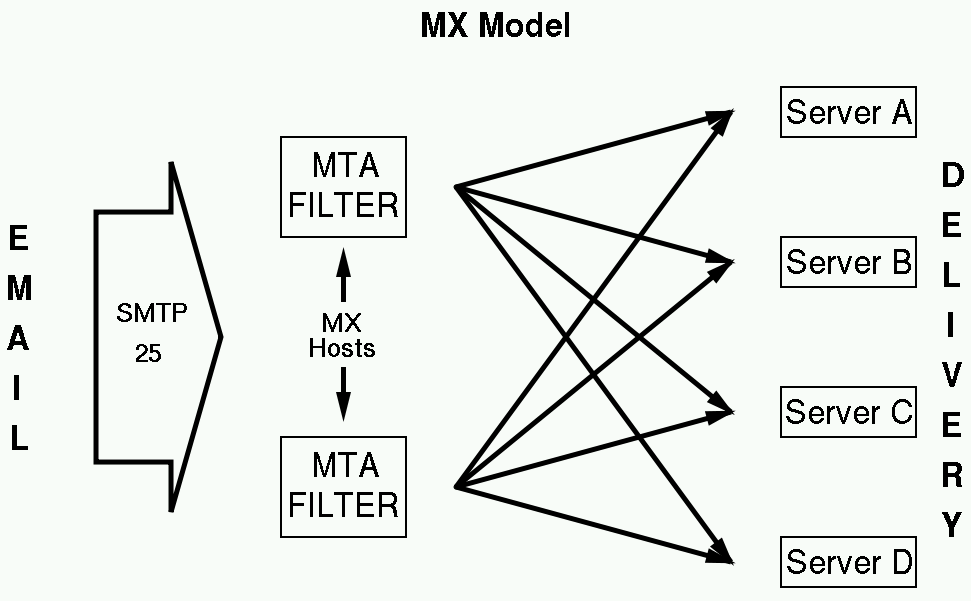
Deployment: MX Filter - Pro and Cons
Pros- Only need a few machines to run the filter
- Redundant backup MXs in case of downtime
- Control over mail queue during/after downtime - We can arbitrarily alter the destination MTA
- Filter for many MTAs: Exchange, Sendmail, Postfix, ... but only the SMTP vector
- Allows us to firewall off client MTAs from the world-at-large
Cons
- One Big One: accepting mail for non-existent@client-mta
- Lots of postmaster mail. We hatesssss that. So, some solutions:
- Make undergrad students read it
- Make list of valid addresses available to Filter (cron jobs, LDAP, etc)
- SnertSoft milter-ahead Thanks to UCI for this, I was going to use milter-cli.
- Lots of postmaster mail. We hatesssss that. So, some solutions:
- Small SMTP delay introduced
- Presence of filter system revealed in Received: headers
Deployment: Network Filter Service in a Nutshell
Not a Network File System, nor a Number Field Sieve
Major Steps
- Build (or buy) one or more systems running your filter(s)
- Make them available via milter or other API
- Configure 'protected' MTAs to access filter via API
- Sit back, relax, have a tasty beverage
Optional
- SMTP-aware Filter(s) as lower priority MXs to queue mail during downtime
- IP firewalls to control access to Network Filter Service
- Again, collect statistics
Deployment: Network Filter Service Diagram
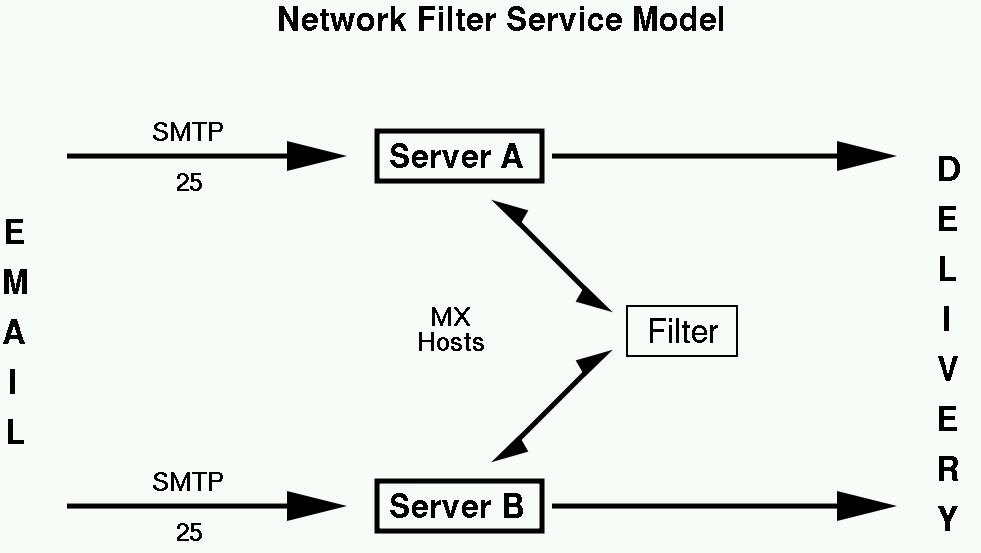
Deployment: Network Filter Service - Pro and Cons
Pros- E-mail goes directly to destination server
- Fewer worries about accepting email for bogus addresses
- One fewer SMTP hop
- Presence of filtering system not announced as openly
- Like the MX Filter, it only needs a few systems for filtering, but only protects SMTP
Cons
- Requires Filtering API support
- May mean more network traffic per filter
- MTAs get e-mail filtering but are still open to outside world
- Don't get mail queue control during downtime without setting up other MXs
It seems cooler, but maybe not better when supporting disjoint heterogenous mail servers. It may work better in a more uniform managed environment, say an end-to-end mail-service as opposed to "just" protecting someone else's servers.
Deployment: A Detour for Exchange
Microsoft Exchange is, for better or for worse, not going to go away anytime soon. The question is "How best to keep the viruses away from it?" First, and perhaps only, relevant thing to remember:
You cannot rely upon SMTP filtering as a sole method of anti-virus for Exchange
For example, users can upload files to Exchange via HTTP, from desktops, PDAs, anything. Where have your users' Crackberrys been?
While it is always a good idea to "pre-filter" mail inbound to an Exchange server, you should also make use of Exchange's VSAPI to provide virus scanning of an item whenever a client requests it, not just when the item (message) is accepted and enqueued. Additionally, items are continually rescanned when virus definitions/signatures are updated.
Implementation: Our version
We went with Filtering MXs for deploying our virus filter.Our guiding principle was "Free Beer Good".
Our tools:
- OS: Solaris 10 on Sparc (Originally 8 and 9)
- MTA: Open Source Sendmail
- Filter I/O: milter
- Filters:
- TrendMicro Viruswall (Sendmail Edition)
- SnertSoft Milter-Ahead (for RCPT Verification)
- Perl
- Caffeine
